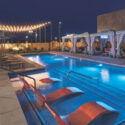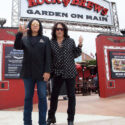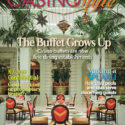In October 2008, Delaware North Companies of Buffalo, NY won the rights to build and operate a casino at Aqueduct racetrack.
That deal fell through in March, a casualty of the recession. But when the bidding reopened a few weeks later, half a dozen companies lined up to vie for the rights-including Delaware North, back for a second go at the lucrative concession.
Aqueduct may be the most prominent racino project in the pipeline today; located in Queens borough, it would be the first casino smack-dab in the middle of New York City. But with 44 racetrack casinos in 12 states seeing double-digit growth despite an economic slump, half a dozen states in the U.S. are now considering these hybrid operations, which are also multiplying in Canada.
For gaming operators and their host states, racetrack casinos are a way to use space already assigned for wagering to expand the gaming menu and generate potential millions in annual revenue. For horsemen, racinos are seen as a way to save a flagging industry and turn a perceived competitor-the casino-into an ally.
‘Racing in its heyday could attract 10,000 people on a Saturday afternoon, but those days are, for the most part, gone,” says Joe Emanuele, vice president of Friedmutter Group Architecture & Design of Las Vegas, which is working on the Coronado Park racino project in New Mexico. “When you add a casino to a racetrack, it’s racing that benefits, with more revenues, more races, better purses. In every jurisdiction I can think of, when a casino comes to the facility, it’s sparked the industry.”
But how to take an existing venue-one that may be decades old, or older-and add space for gaming that makes sense, aesthetically and from a practical standpoint?
“The challenge,” says Emanuele, “is to integrate the two sides so people feel they’re coming to a new place, an integrated entertainment facility, and not the same old racetrack.”
But in this race, the track doesn’t want to be perceived as coming in second. Though the racing season is brief and most casinos run 24/7, track owners-usually diehard horse people-want to maintain the sport of kings and the loyalty of horse bettors, who may have patronized a facility for years before gaming came along.
“It’s an expansion of the base, not a shift from one to the other,” says Emanuele. “In addition to the benefit for racing of casinos and slot machines, people on the casino side are getting an introduction to the kind of nostalgic leisure activity their grandparents enjoyed-the tranquility of horses and green spaces.”
Old Meets New
The balance between racing and gaming has been achieved with notable success at Oaklawn Park in Hot Springs, Arkansas. The venerable century-old racetrack raised its purses twice this year for a total of almost $16 million, and even added a $500,000 “participation incentive.” The racing handle is up 3 percent, and track attendance over the 54-day meet is up too-to more than 625,000 people.
This fiscal renaissance, which has been clearly linked to gaming, started modestly. In 2000, Oaklawn equipped two small rooms under its grandstand with 50 electronic “historic racing” games. Spurred by the success of those rooms, in 2003 track owners added a 37,500-square-foot space with 500 more games. And in May, Oaklawn completed a $40 million expansion with 650 games including electronic poker and blackjack. Another addition, to be complete next year, will include up to 1,100 total gaming positions, a buffet and restaurant, and a poker room in a total of 90,000 square feet.
The architect for the recent expansion is Hnedak Bobo Group of Memphis. At Oaklawn, designer Shawn Hobbs and principal Craig Conrad found obstacles galore, both literal and figurative: a venue built to obsolete code; a long, a linear grandstand with “a lot of columns where you don’t want them;” and little of the technological infrastructure needed for gaming.
To integrate all-new casino space with an aging structure required “a lot of calisthenics in terms of moving electrical services and building firewalls,” as well as installing hidden systems (surveillance, air quality, sound), Hobbs says.
Though the design team at one point considered a freestanding hall, operational efficiencies demanded that everything remain under one roof. A buffet, kitchen and other amenities were tucked under the grandstand; the formula for a traditional casino floor required some tinkering too.
“Casinos are usually rectangular or square, with retail and restaurants on the perimeter to activate and energize the floor,” says Hobbs. But at Oaklawn, new gaming space was “plugged onto one end of the existing space and wrapped around” the long, four-story grandstand.
To match the new wing to the older structure (which was built in three stages from 1958 through 1979), the Hnedak Bobo team employed “a simple aesthetic with simple materials” for a streamlined look, says Conrad.
“Our building is designed to be a little more austere, with the excitement and ‘wow’ factor on the interior.”
Shared space is accessed from two different entryways for two different sets of patrons-a necessity, as the legal age to gamble in Arkansas is 21, and racing for many in the state is a family affair. The visual transition between racing and gaming areas is made through the use of design features overhead and underfoot.
“We continue strong planes or elements in the ceiling, repeating them from the old space to the new” for a cohesive look, says Hobbs. “In the floor pattern and carpeting, we also carry ideas visually in the field of view from one place to the other to make it look seamless.”
Though there is no overt nod to horse racing in the gaming section, he adds, subtle references can be found by anyone who looks for them.
“Not many people pick up on it, but the floor pattern of the casino includes an abstract theme, a series of galloping horses,” he says. “What we tried to do is conceptually integrate ideas of speed, of dynamic movement, without being obvious.”
As for rebranding the facility to reflect new gaming options, the Cella family, which owns Oaklawn, emphasized tradition.
“Oaklawn is the oldest privately owned track in the country; that name has far more brand recognition than any other name they’d come up with,” says Conrad. “This game room has essentially become an amenity, an additional offering that’s evolved over time.”
Hence the name Oaklawn Racing & Gaming.
Shipyard Challenge
SOSH Architects of Atlantic City and New York faced a unique scenario when they took on the design of Harrah’s Chester, a racino on the Delaware River outside Philadelphia. Unlike other racinos, Harrah’s Chester was built from the ground up, on the site of the former Sun Shipyards.
Casino officials selected the site “because they felt that when gaming was passed in Pennsylvania, track licenses would be cut loose first,” says SOSH founding partner Tom O’Connor. “Harrah’s proposed a site with neither part of the development in place, in hopes that they could jump-start their chances of opening and have a year of operations before slots were approved. And they were dead-on.”
The look of the facility was inspired by the area’s industrial past; the configuration was dictated by its riverfront locale.
“We took our cues from the industry we replaced,” says O’Connor. The result is “a kind of retro industrial chic in terms of building materials. We maintained the steel frame of the existing building, kept the structural bones, and built a new outer shell. And we dropped the track along the river.”
But with just 60 acres at their disposal-racetracks typically require 180 to 200 acres-“that left a pretty minimal area for the casino, which led to different architectural solutions,” O’Connor says. “We had to stack everything.”
The result is a four-story, 400,000-square-foot facility with 3,000 slot machines joined to the racing oval by a pedestrian bridge. The ground level is the entranceway with valet parking; 20 feet up is the racing level with grandstands, simulcasts and some dining; 20 feet above that is the 150,000-square-foot casino.
Harrah’s Chester “has a very long, linear feel, and the challenge there was to create attractions to pull you,” says O’Connor. “You don’t want to feel like it’s a hike-it should feel like a quest, where you discover things along the way. A lot of the food venues are a magnet to pull people through the space. There’s a diner, a 24-hour buffet, a sports restaurant and a fine-dining clubhouse.”
Construction of the 5/8-mile track presented its own difficulties. The onetime shipyard included old shipways that, for environmental reasons, could not be filled.
“We are not racing people,” says O’Connor. “So we went where people know how to design racetracks-Lexington, Kentucky.”
To complete the track, they bridged the shipways and then screened them, so horses would not realize that in the banked second turn of the race, they are actually running over water.
Advice from the horsey set is indispensable during the design phase, observes Hnedak Bobo’s Hobbs. When the firm’s designers were developing Oaklawn, they were told to avoid the colors blue and green.
“Most people speculate that horses are color blind, but they do see color values, and bright or highly contrasting shades can startle them,” says Hobbs. “You don’t want a horse like Smarty Jones getting scared and running off the end of the track.”
Vegas at the Track
Hailed in Global Gaming Business magazine as “Vegas at the track,” the Meadows racino near Pittsburgh, a Cannery Resorts property, opened with a bang on April 15. Even on tax day in the middle of a recession, 10,000 patrons flocked to the racino, jamming the highway for hours and setting new records in the Keystone State.
The transformation of a 45-year-old standardbred track into a multi-purpose destination cost $175 million-a modest investment considering the result. With multiple restaurants and bars, retail spaces, a banquet hall and even a 24-lane bowling alley, the all-new Meadows is an artful fusion of gaming, racing and entertainment that transitions logically from one sector to the next.
“Integrating the racing and gaming components maximizes the synergies in all of the facilities,” says project architect David Climans of Climans Green Liang of Toronto, specialists in racino design. “It was one of our main objectives to make the racing and gaming somewhat seamless.”
On the casino side, designers went for a true Las Vegas vibe, with subdued lighting, high ceilings and oversized color portraits of the Las Vegas Cannery casinos. CGL and interior design firm Yates-Silverman Inc. also evoked “a subtle equestrian image” within “an exciting timeless design and sophisticated atmosphere,” according to Climans.
Though there has not been much overlap between the racing customer and the gaming customer, “positive cross-traffic can be encouraged with an open flow from the gaming floor to racing, while respecting the individual needs of the distinctly different customers,” says Climans. “By having restaurants that overlook the racetrack, the excitement of racing will hopefully be felt by the patrons who originally came to play slots.
Casino vs. Racing
But variations are inevitable in the two spaces.
At Oaklawn Park, it was not economical to upgrade finishes in the grandstand: “It’s only used 60 days a year,” says Craig Conrad, “and it doesn’t pay to spend a whole lot of money to renovate.”
Finishes in the casino, however, had to be lustrous, he says. “Gone are the days of putting gaming machines on a concrete floor. Mainstream customers are going to expect what they see in other gaming environments.”
“It’s hard for racetracks to justify putting in higher-level amenities for a finite operation that runs for such a short period,” agrees Larry Tombari, president of business development for the Friedmutter Group. “But gamers coming in with higher budgets can invest in them.”
Because racetracks and casinos attract different customers at different times of the day and night, it’s vital that the casino side “announce” itself with an entryway that is more formal and glamorous, says Friedmutter’s Emanuele.
“Whether that is a porte cochere or not, the access, the first impression of the facility is one of the most important statements.”
As columnist Joe Bob Briggs wrote in 2003, “The only racetracks to really thrive are the ones that have slot machines. In many cases their live handle has continued to decline, but their revenues have shot up so fast that they’re able to offer the biggest purses, and thereby attract the best horses.”
Six years later, Tombari echoes that sentiment. “In virtually every state that’s tried it,” Tombari says, “racinos have basically saved horse racing.”












